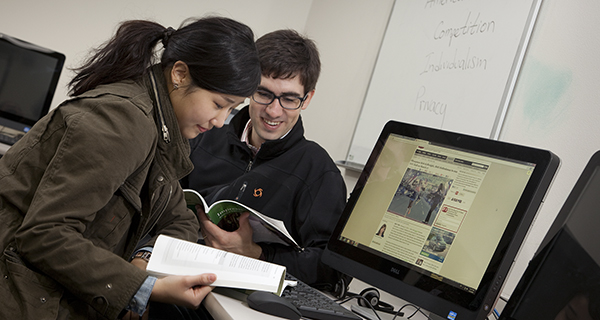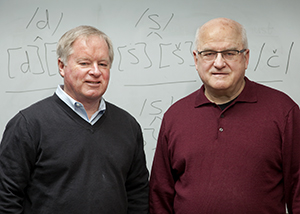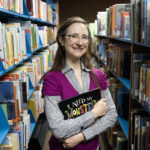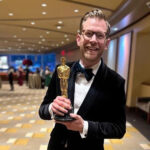
Sounds are the building blocks of language, but they can be a stumbling block for those who are trying to learn a new language.
Two University of Wisconsin-Milwaukee linguistics researchers are trying to unlock some of the fundamental challenges to second-language acquisition.

Fred Eckman and Gregory Iverson are involved in a study, funded by the National Institutes of Health (NIH), looking at how the sounds and principles of pronunciation in a person’s native language impact the way he or she learns English. Eckman is a UWM Distinguished Professor and Iverson a professor in the Department of Linguistics.
Their research has focused primarily on challenges faced by native speakers of Japanese, Korean and Spanish. For example, Japanese and Korean students learning English have difficulty differentiating the pronunciation of words that start with “s” and “sh,” like “sip” and “ship.”
“English, Japanese and Korean all have these sounds [‘s’ and ‘sh’], but only in English can we use the sounds, particularly before ‘i’ at the beginning of words, to make different words,” explains Eckman.
Documenting these types of specific linguistic challenges is important on several levels, says Iverson.
“NIH is interested because of the difficulties immigrants have in assimilating and becoming part of the U.S., and language development is part of that,” he says. In addition, studies of how learners acquire second languages “can help us better understand the learning process itself. It’s one small aspect of how learning goes on.”
While Eckman and Iverson have focused on Korean, Japanese and English, they and doctoral students working with them have also done some work with Russian, Thai and Arabic. They’ve published a number of papers on the results, most recently in Studies in Second Language Acquisition.
Pronunciation challenges can be similar among dissimilar languages, says Iverson. For example, both Spanish – an Indo-European language – and Korean and Japanese – Asian languages – have pronunciation rules that make learning English pronunciation more difficult.
“It’s interesting from a second-language acquisition point of view that the same kind of patterning with respect to ‘s’ and ‘z’ in Spanish parallels what happens with the ‘s’ and ‘sh’ in Japanese and Korean,” says Iverson.
Native Spanish speakers don’t distinguish between “s” and “z” sounds, he explains, making it difficult for them to learn the difference between English words like “sip” and “zip.”
Another phenomenon they found for Spanish speakers in the Western Hemisphere was difficulty making the distinction between ‘d’ and ‘t,’” adds Iverson. “Both of those sounds also exist in Spanish, but as variants of the same sound.… For a Spanish speaker learning English, this is a crucial distinction they are going to have to learn to make if they’re going to distinguish between words like ‘they’ and ‘day.’”
At the same time, Eckman and Iverson have found that even languages that have similar sounds and rules provide challenges for English-language learners. While both Japanese and Korean native speakers have trouble distinguishing the “s” and “sh” sounds in English words, they make different types of mistakes, based on pronunciation rules in their native languages.
For example, Eckman explains, in Korean, when the “sh” sound is used, it’s only before the “i” vowel sound, except in words borrowed from foreign languages – like “syaweo” for “shower.” The Japanese language, however, uses “sh” before other vowels, such as in the word “shogun.”
So a Korean learning English might feel the need to put in that “i” sound required in his or her native language, explains Eckman. A native Korean speaker might pronounce the former president’s name as George “Busi,” while a native Japanese speaker might say “Busshu. “
“The freedom of occurrence of the ‘sh’ sound is limited, but even more so in Korean than in Japanese,” says Eckman. “To relax these limitations; to undo and remove what you’ve learned to do in your native language for 20 years or more – to remove that speech habit – is difficult.”
And some learners get to the point where they think they’ve learned the distinction so well that they hypercorrect – “even to the point where they’re using the ‘sh’ sound in more positions than they should be doing.”
Their research isn’t designed to provide recommendations on how to teach English as a second language, notes Eckman. However, the findings can help teachers identify how the sounds and pronunciation rules of the native language result in different consequences and patterns of errors in learning English.
“We’ve found that learning proceeds in stages. It’s not all one fell swoop. People learn progressively and even go beyond what native speakers do. All of this is part of the developmental process that is the core of what we’ve been trying to investigate.”
ESL program receives national accreditation
The University of Wisconsin-Milwaukee’s English as a Second Language (ESL) program has received national accreditation. A new federal law, signed by President Barack Obama in 2010, requires that all English- language training programs must be accredited by a regional or national accrediting agency recognized by the Department of Education.
UWM’s program had already begun the accreditation process at that point, and received initial accreditation in December 2011 from the Commission on English as a Second Language Accreditation Program. The goal of accreditation, according to the commission, is to help institutions gauge their effectiveness against standards developed by professionals in the field and benchmarks set by the profession.
The UWM program received its four-year accreditation from the commission in December 2012.
The 2010 Accreditation of English Language Training Programs Act, amended immigration laws to require that nonimmigrant students intending to pursue an English-language course of study must enroll in an accredited English- language training program. The Student and Exchange Visitor Program (SEVP) is responsible for reviewing SEVP-certified English-language programs for compliance with the law’s accreditation requirements.






